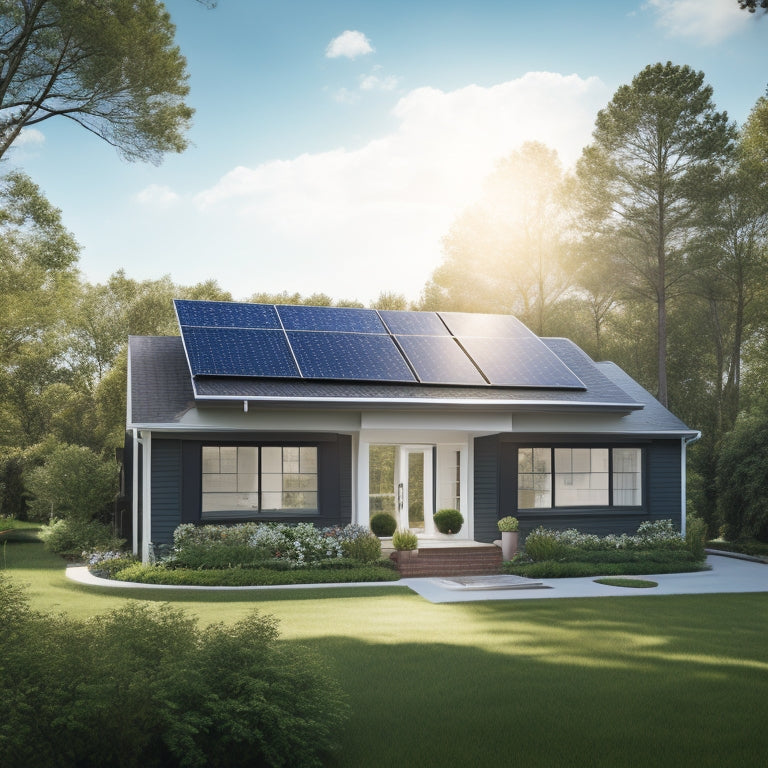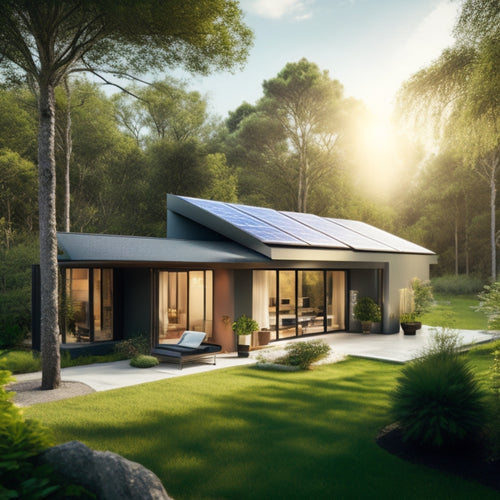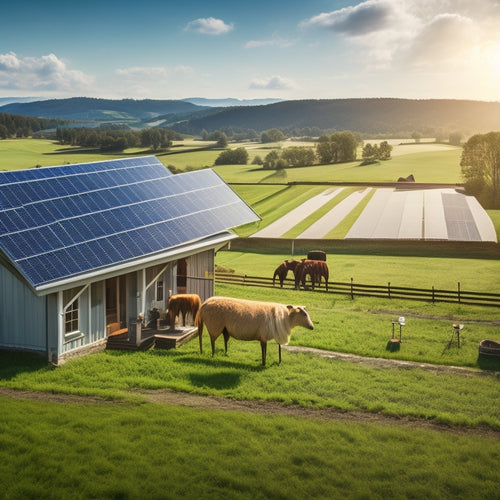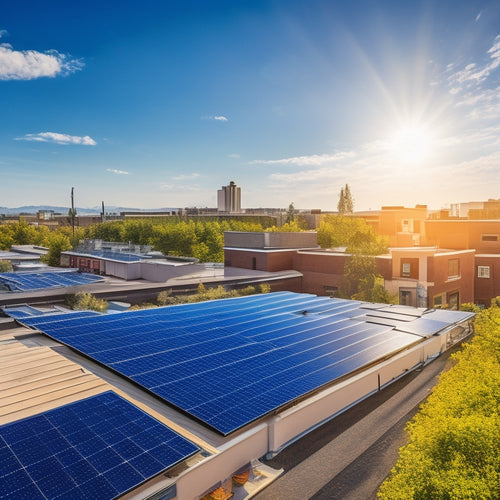
What You Need to Know About Solar Power Home Panels
Share
You're contemplating solar power home panels, which convert sunlight into electricity using photovoltaic technology. They provide clean, sustainable energy, reducing your reliance on traditional power sources. You'll want to understand the types of solar panels available, including monocrystalline, thin film, and polycrystalline, each with its unique characteristics affecting energy output and savings. You'll also need to evaluate the upfront costs of installation, financing options, and ongoing maintenance costs, as well as the benefits of solar power, including increased property value, lower energy bills, and energy independence. Now that you've taken the first step, you're ready to investigate the details that'll help you make an informed decision.
Key Takeaways
- Solar power home panels convert sunlight into electricity using photovoltaic technology, providing clean and sustainable energy.
- There are three main types of solar panels: monocrystalline, thin film, and polycrystalline, each with unique characteristics affecting energy output and cost.
- Solar power offers several benefits, including reduced energy bills, increased property value, and a lower carbon footprint, leading to long-term savings.
- The initial cost of solar panel installation can range from $15,000 to $25,000 or more, but financing options and tax incentives are available to offset costs.
- Ongoing maintenance costs are relatively low, averaging $100 to $300 per year, with occasional inverter replacement and unexpected repairs.
How Solar Power Home Panels Work
Across your roof, solar power home panels convert sunlight into electricity through a fascinating process. This solar energy conversion occurs through photovoltaic technology, where sunlight excites electrons in semiconducting materials, causing them to flow through a circuit. As you install these panels, you're fundamentally utilizing the sun's energy to power your home.
The process begins when sunlight hits the photovoltaic cells, made from silicon, within the panels. These cells are arranged in a grid-like pattern to maximize energy absorption. As sunlight interacts with the cells, it energizes the electrons, allowing them to flow freely.
This flow of electrons creates a direct current (DC) electricity, which is then converted into alternating current (AC) electricity through an inverter. The AC electricity is now compatible with your home's electrical system, allowing you to power your appliances and devices.
Through this efficient process, you can generate clean and sustainable energy, reducing your reliance on traditional power sources.
Benefits of Solar Power for Homes
As you employ the sun's energy to power your home, you'll start to reap the rewards of solar power. One of the most notable advantages is the reduction of your reliance on the grid, granting you energy independence. This means you'll be less affected by power outages and rate hikes.
Here are three key benefits of solar power for homes:
-
Environmental impact: Solar power is a clean and renewable source of energy, producing no emissions or pollution. This reduces your carbon footprint, contributing to a healthier environment.
-
Increased property value: Installing solar panels can increase your property value, making your home more attractive to potential buyers if you decide to sell.
-
Lower energy bills: Solar power can notably reduce your energy bills, saving you money in the long run.
Cost of Solar Panel Installation
As you consider installing solar panels on your home, you'll need to factor in the initial investment, which includes the cost of the panels, installation, and other equipment.
You'll also want to account for ongoing maintenance costs, such as cleaning and repairing the system, to guarantee peak performance.
Initial Investment Breakdown
How much does it cost to capture the power of the sun in your own backyard? The initial investment breakdown for solar power home panels can vary depending on several factors, including the size of your system, the quality of equipment, and the installation company you choose.
Here's a breakdown of the typical costs:
-
Equipment costs: This includes the solar panels, inverters, mounting hardware, and other necessary components. These costs can range from $15,000 to $25,000 or more, depending on the size and quality of the system.
-
Labor costs: This includes the cost of hiring a professional installation team to install the system. Labor costs can range from $5,000 to $10,000 or more, depending on the complexity of the installation.
-
Permitting and inspection costs: This includes the costs associated with obtaining necessary permits and undergoing inspections to verify the system meets local building codes. These costs can range from $1,000 to $2,000 or more.
Fortunately, there are financing options available to help make solar power more accessible.
You may also be eligible for tax incentives, such as the Solar Investment Tax Credit (ITC), which can help offset the upfront costs of your system.
Ongoing Maintenance Costs
Your solar power home panels are now installed, and you're utilizing the energy of the sun to power your home. While the initial investment may seem substantial, it's crucial to take into account the ongoing maintenance costs to guarantee long-term savings.
In general, solar panels require minimal maintenance, with an average annual cost of $100 to $300. This includes routine cleaning, inspecting electrical connections, and monitoring system performance.
You may also need to replace the inverter, which converts DC power to AC, every 10 to 15 years, costing around $1,000 to $3,000.
However, unexpected repairs can arise, such as damaged panels or faulty wiring. These repairs can range from $500 to $2,000 or more, depending on the extent of the issue.
To mitigate these risks, think about investing in a maintenance contract or warranty that covers repairs and replacements. By factoring in these ongoing maintenance costs, you can better plan your budget and enjoy the long-term savings that come with utilizing the power of the sun.
Types of Solar Panels Available
When it comes to utilizing the power of the sun, you're faced with a multitude of solar panel options, each boasting its unique set of characteristics, advantages, and disadvantages.
As you traverse the market, it's crucial to understand the differences between each type to make an informed decision for your solar power home panels.
Here are three primary types of solar panels available:
-
Monocrystalline Panels: These panels are made from a single crystal of silicon, offering high efficiency rates and a sleek appearance. However, they're often more expensive than other options.
-
Thin Film Panels: Thin film panels are composed of multiple layers of photovoltaic material, making them more affordable and flexible. While they're less efficient than monocrystalline panels, they're better suited for large-scale installations.
-
Polycrystalline Panels: Polycrystalline panels are created from multiple crystals of silicon, offering a balance between efficiency and cost. They're a popular choice for residential solar power systems due to their affordability and decent performance.
Understanding the advantages and disadvantages of each type will help you select the most suitable option for your solar power home panels, ensuring you maximize your energy output and savings.
Installation and Maintenance Tips
When installing solar power home panels, you'll want to guarantee ideal energy harvesting by carefully considering panel placement.
Regular cleaning will also be necessary to maintain efficiency, as dirt and debris can greatly reduce energy output.
To avoid potential pitfalls and guarantee a successful installation, it's highly recommended that you hire a professional to get the job done.
Panel Placement Matters
Optimizing the placement of solar panels on your roof is crucial to maximize energy production and minimize potential issues.
You want to guarantee your panels are positioned to capture the most sunlight possible while avoiding obstacles that could reduce their efficiency.
To get it right, consider the following factors:
-
Optimal orientation: Confirm your panels face the direction that receives the most sunlight throughout the day. In the northern hemisphere, this is typically south-facing.
-
Shading analysis: Identify any potential shading sources, such as trees, buildings, or chimneys, and position your panels to avoid them. Even partial shading can appreciably reduce energy output.
-
Roof layout and obstructions: Take into account the layout of your roof, including vents, skylights, and other obstructions, to determine the best placement for your solar panels.
Regular Cleaning Required
As you've carefully positioned your solar panels to maximize energy production, it's vital to maintain their efficiency by cleaning them regularly. Dust, dirt, and debris can reduce energy output by up to 25%, making regular cleaning necessary. You should clean your solar panels every 6-12 months, depending on the environment.
If you live in an area with high levels of pollution, dust storms, or near agricultural areas, you may need to clean them more frequently.
When cleaning your solar panels, use a soft-bristled brush or a specialized solar panel cleaning tool to remove loose debris. Avoid using harsh chemicals, abrasive materials, or high-pressure washes, as they can damage the panels.
Instead, use a mild soap solution and distilled water to clean the panels. For more thorough cleaning, consider hiring a professional or investing in an automated cleaning system.
Professional Installation Advised
Nearly 90% of solar panel owners opt for professional installation, and for good reason. You want to verify that your solar power system is installed correctly to maximize energy production and longevity.
While it may be tempting to DIY, professional installation guarantees a flawless installation process.
When hiring an installer, consider the following:
-
Installer qualifications: Look for certifications from organizations like the North American Board of Certified Energy Practitioners (NABCEP) or the International Association of Electrical Inspectors (IAEI).
-
Installation process: A professional installer will assess your roof's condition, verify proper panel placement, and connect the system to your electrical grid.
-
Warranty and support: Reputable installers typically offer warranties and maintenance services, giving you peace of mind and protection for your investment.
Is Solar Power Right for You
You're likely considering solar power for your home, but before investing, it's vital to determine if solar power is right for you. Several solar power benefits make it an attractive option, including reduced energy bills, increased property value, and a smaller carbon footprint.
However, there are also solar energy considerations to keep in mind. First, assess your energy usage and consumption patterns. If you have high energy demands, solar power mightn't be enough to meet your needs.
Additionally, consider your roof's size, orientation, and shading. A south-facing roof with minimal shading is ideal for solar panels. Your location's climate and local building codes also play a role in determining the feasibility of solar power.
Lastly, evaluate the upfront cost and financing options. While the initial investment may seem steep, solar power can provide long-term savings and potential tax incentives.
Frequently Asked Questions
Can I Install Solar Panels on My Own or Diy?
You can attempt a DIY solar panel installation, but you'll need to guarantee you meet installation requirements and prioritize DIY safety, as improper mounting and electrical connections can be hazardous and void warranties.
How Do Solar Panels Perform During Power Outages?
During power outages, you'll find that your solar panels won't provide electricity unless you have a battery backup system, ensuring grid independence; however, they'll still generate power, maintaining solar panel efficiency, when the grid is restored.
Are Solar Panels Recyclable at the End of Their Life?
You'll be glad to know that solar panels are recyclable, with many manufacturers developing recycling processes to recover precious solar panel materials like silicon, glass, and metals, reducing waste and promoting sustainability at the end of their life.
Can I Use Solar Panels to Charge My Electric Vehicle?
As you fuel your eco-friendly dreams, you're wondering if solar panels can juice up your electric vehicle. The answer is yes! With a solar panel efficiency of around 20%, you can utilize enough power to charge your ride, reducing your carbon footprint and dependence on the grid.
Do Solar Panels Void My Roof's Warranty?
When you install solar panels, you won't necessarily void your roof's warranty, but you'll need to guarantee the installation meets manufacturer guidelines to avoid roof warranty implications; follow strict solar panel installation guidelines to mitigate risks.
Conclusion
You've now got an extensive understanding of solar power home panels. Notably, did you know that a typical residential solar panel system can save up to $500 per year on electricity bills? With the cost of installation decreasing by 70% over the last decade, solar power is becoming an increasingly viable option for homeowners. Weigh the benefits and consider making the switch to renewable energy - your wallet and the planet will thank you.
Related Posts
-

Top-Rated Solar Storage Solutions for Homeowners
When considering top-rated solar storage solutions, you're looking at systems that provide energy independence and si...
-

Solar Power Systems for Rural Properties
Solar power systems offer a reliable and efficient energy solution for rural properties, allowing you to gain energy ...
-

Solar Energy Solutions for Small Businesses
Switching to solar energy can be a game changer for your small business. You'll enjoy significant cost savings on mon...


